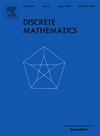A large minimal blocker for 123-avoiding permutations
IF 0.7
3区 数学
Q2 MATHEMATICS
引用次数: 0
Abstract
A set is a blocker of a subset of the symmetric group if every permutation allows an index i with . Bennett, Brualdi and Cao conjectured that is an upper bound for the sizes of the inclusion minimal blockers of the family of 123-avoiding permutations, which are those for which has no increasing subsequence of the length three. We show that is a counterexample to the conjecture, where the ⁎'s denote the positions in the blocker.
一个大的最小阻挡123避免排列
如果每个排列σ∈Qn允许有索引i且(i,σi)∈B,则集合B是对称群Sn的子集Qn的阻塞子。Bennett, Brualdi和Cao推测,在123避免排列族中,≥(n+1)/2≥⌊(n+1)/2⌋是包含最小阻挡子的大小的上界,即σ∈Sn对于(σ1,…,σn)没有长度为3的递增子序列。我们展示thatB =(0000⁎0⁎00⁎⁎00⁎00000000⁎0⁎⁎0⁎0000⁎000⁎0⁎⁎0⁎0⁎0⁎00⁎)是一个反例的猜想,在⁎表示拦截器的位置。
本文章由计算机程序翻译,如有差异,请以英文原文为准。
求助全文
约1分钟内获得全文
求助全文
来源期刊

Discrete Mathematics
数学-数学
CiteScore
1.50
自引率
12.50%
发文量
424
审稿时长
6 months
期刊介绍:
Discrete Mathematics provides a common forum for significant research in many areas of discrete mathematics and combinatorics. Among the fields covered by Discrete Mathematics are graph and hypergraph theory, enumeration, coding theory, block designs, the combinatorics of partially ordered sets, extremal set theory, matroid theory, algebraic combinatorics, discrete geometry, matrices, and discrete probability theory.
Items in the journal include research articles (Contributions or Notes, depending on length) and survey/expository articles (Perspectives). Efforts are made to process the submission of Notes (short articles) quickly. The Perspectives section features expository articles accessible to a broad audience that cast new light or present unifying points of view on well-known or insufficiently-known topics.
 求助内容:
求助内容: 应助结果提醒方式:
应助结果提醒方式:


